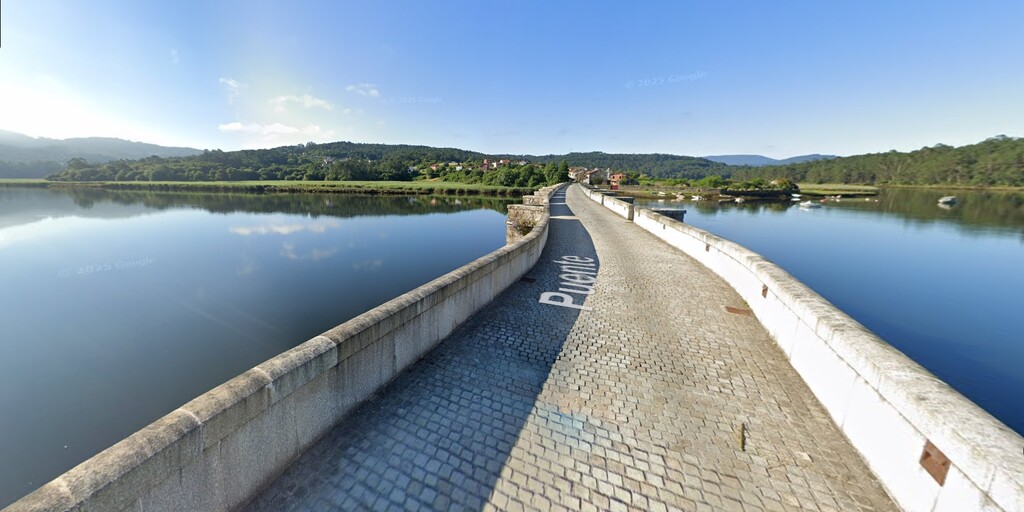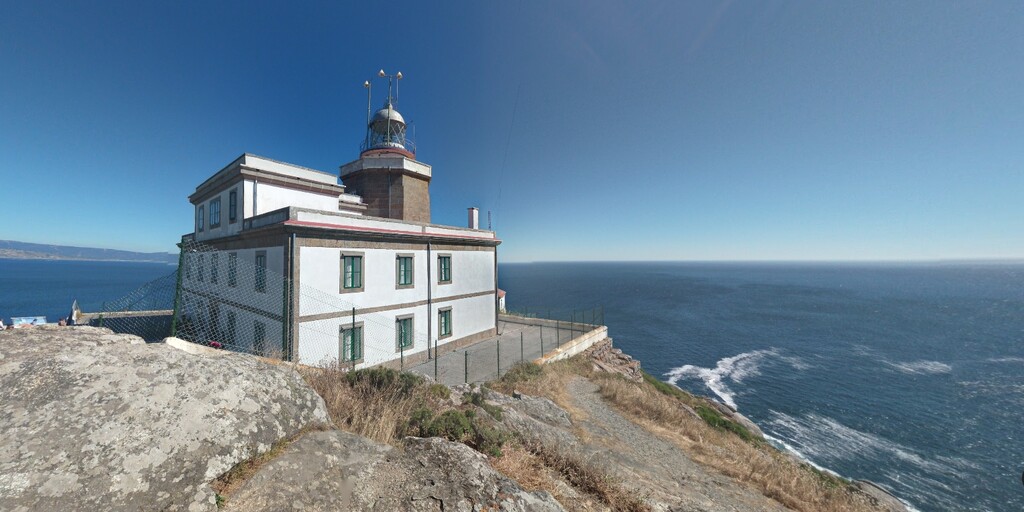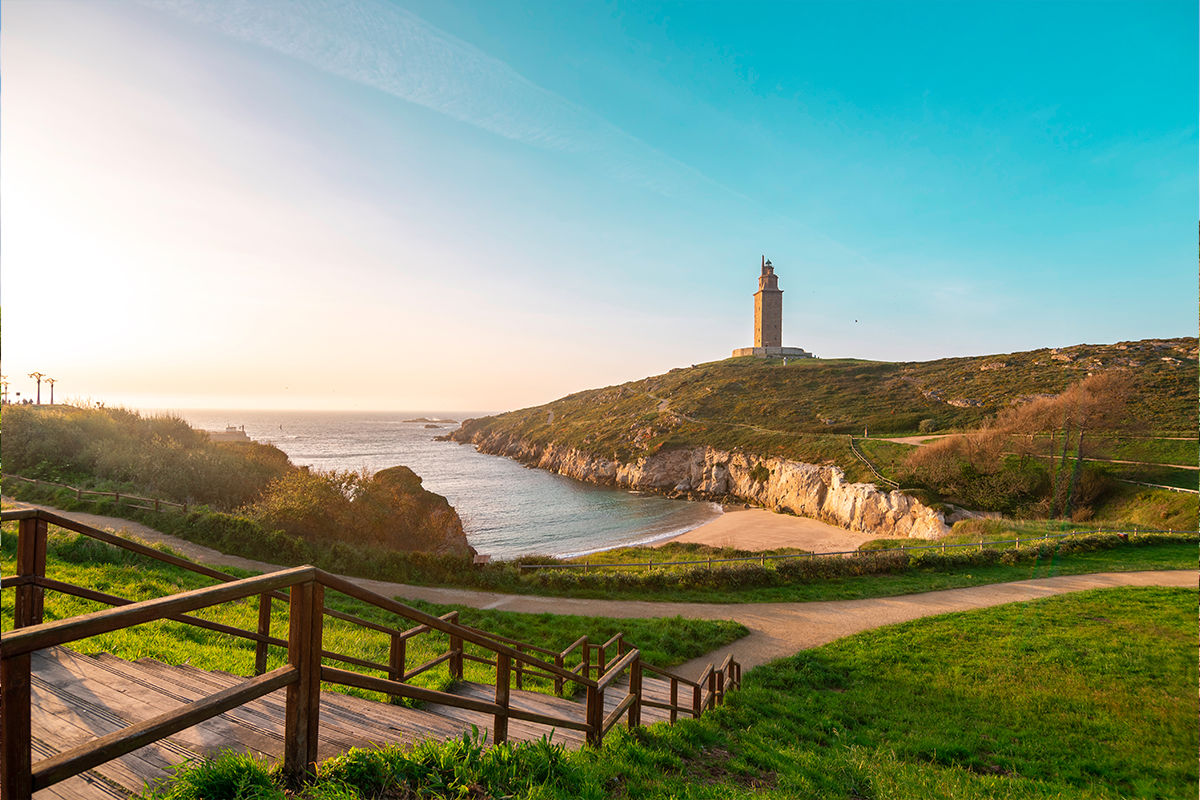
Round trip from Negreira visiting Cape Finisterre Cape Tourinan and Muxía

This route was brought to you by:
RouteXpert Nick Carthew - (MRA Master)
Last edit: 31-07-2025
 Route Summary
Route Summary I have awarded this route with 4 stars**** The roads are good and the scenery and attractions are very good.
 Share this route
Share this route 




Animation

Verdict


Duration
6h 48m

Mode of travel
Car or motorcycle

Distance
213.59 km

Countries


Miradoiro do Ézaro
 RouteXpert Review
RouteXpert Review A paradise surrounded by rivers and lush forests where Roman history and architecture are still present. Just a few kilometres from Santiago de Compostela, it is a stopover for pilgrims traveling to Santiago along the Maritime Way or those who decide to follow the route to reach the End of the World in Finisterre.
Costa de la Muerte; "Death Coast". Rocky headlands, winding inlets, small fishing towns, plunging cliffs, wide sweeping bays and many a remote, sandy beach – this is the eerily beautiful 'Coast of Death'.
The route heads out of Negreira and travels towards the spectacular coastline that this area is known for by following the DP-5602. This road is surfaced along it's entire length but is very narrow in places as you pass through the forested areas. It has a feeling of a forest trail in places as the trees are so close and the road so narrow, very enjoyable though.
The route reaches the Tambre River and uses a bridge that was called “Ponte das Pías” in medieval documents. It crosses the Tambre River and links the municipalities of Outes and Noia, serving as the border between the two. Before it was built, people had to cross the estuary by boat. It owes its present-day appearance to medieval modifications and the reconstruction that was carried out between 1842 and 1844. The cobblestone surface makes it more attractive.
The route crosses over the Tambre river two more times, the last time using the Ponte do Langaño bridge then you'll
follow the coastline passing through the harbour town of Muros where you will see the Rebordiño Lighthouse situated at the southern entrance to the town it is declared a Site of Special Historic-Artistic Interest and dates back to 1909.
A short distance from the lighthouse there is a layby where you can stop for a photo of great views across the estuary Ría de Muros e Noia towards Porto do Son and beyond.
There are many viewpoints to stop for photo's and a particularly good one is the Miradoiro do Ézaro viewpoint which has a magnificent vista of the mouth of the Rio Xallas, the granite slopes of Mount Pindo, the cove of O Ézaro, the small Lobeiras islands and the unmistakable shape of Cape Finisterre in the background.
The route now heads for Cape Finisterre which for some on the Santiago de Compostela pilgrimage is their end point.
Cape Finisterre, known as Spain’s Land’s End, is where the Camino de Santiago truly reaches its conclusion.
Its name, Finis-terrae—“the end of the earth”—was bestowed by the Romans, who believed this was the edge of the known world. Here, they performed nightly sacrifices to ensure the Sun’s safe return each morning.
This coastline is known as Costa da Morte (Coast of Death) as it is one of the most dangerous coastlines in Europe. Over the centuries, its treacherous waters caused many shipwrecks, claiming the lives of countless sailors. Towering waves crash violently against the cliffs, creating an intense and dramatic landscape. It’s easy to understand why this place feels both awe-inspiring and eerie.
The legendary Lighthouse of Finisterre was constructed in the year of 1853 at the tip of Cape Finisterre. When the skies are clear and the sun is shining brightly, one can enjoy the view of the famous Galician lighthouse from up to 30 kilometres out at sea. The lighthouse is a reminder of numerous marine battles that occurred between the French and English around the cape.
A little further up the coast is Cape Touriñan, the most western point in Spain and another lighthouse, well two actually. The first lighthouse at Touriñán, was completed in 1898, and consists of a single storey keeper's house with the tower centrally located at the apex of the roof. A new lighthouse, which was built adjacent to the original building first entered service in 1981. It consists of a 11m high cylinder-shaped tower, that supports twin galleries and a lantern with a grey cupola.
A short 30 minute ride from here takes you to Muxia, a small town with a little more than 5,000 inhabitants found on the Costa da Morte in the province of A Coruña. The main attraction of this seafaring village is its coast, from which you can observe the fierceness of the Atlantic Ocean. However, that’s not the only draw, since eating in Muxia is also a pleasure. If you love seafood, you can’t miss eating in Muxia so I have suggested a lunch stop here.
After lunch the route heads back to the start point at Negreira, a gentle ride taking approximately 45 minutes, so you can indulge yourself to a slap-up meal.
Enjoy

Ponte das Pías

Finisterre Lighthouse
 Usage
Usage Want to download this route?
You can download the route for free without MyRoute-app account. To do so, open the route and click 'save as'. Want to edit this route?
No problem, start by opening the route. Follow the tutorial and create your personal MyRoute-app account. After registration, your trial starts automatically.  Disclaimer
Disclaimer
Use of this GPS route is at your own expense and risk. The route has been carefully composed and checked by a MyRoute-app accredited RouteXpert for use on TomTom, Garmin and MyRoute-app Navigation.
Changes may nevertheless have occurred due to changed circumstances, road diversions or seasonal closures. We therefore recommend checking each route before use.
Preferably use the route track in your navigation system. More information about the use of MyRoute-app can be found on the website under 'Community' or 'Academy'.
Changes may nevertheless have occurred due to changed circumstances, road diversions or seasonal closures. We therefore recommend checking each route before use.
Preferably use the route track in your navigation system. More information about the use of MyRoute-app can be found on the website under 'Community' or 'Academy'.

Galicia
About this region
Galicia (; Galician: Galicia [ɡaˈliθjɐ] or Galiza [ɡaˈliθɐ]; Spanish: Galicia, Portuguese: Galiza) is an autonomous community of Spain and historic nationality under Spanish law. Located in the northwest Iberian Peninsula, it includes the provinces of A Coruña, Lugo, Ourense and Pontevedra.
Galicia is located in Atlantic Europe. It is bordered by Portugal to the south, the Spanish autonomous communities of Castile and León and Asturias to the east, the Atlantic Ocean to the west, and the Cantabrian Sea to the north. It had a population of 2,701,743 in 2018 and a total area of 29,574 km2 (11,419 sq mi). Galicia has over 1,660 km (1,030 mi) of coastline, including its offshore islands and islets, among them Cíes Islands, Ons, Sálvora, Cortegada Island, which together form the Atlantic Islands of Galicia National Park, and the largest and most populated, A Illa de Arousa.
The area now called Galicia was first inhabited by humans during the Middle Paleolithic period, and takes its name from the Gallaeci, the Celtic people living north of the Douro River during the last millennium BC. Galicia was incorporated into the Roman Empire at the end of the Cantabrian Wars in 19 BC, and was made a Roman province in the 3rd century AD. In 410, the Germanic Suebi established a kingdom with its capital in Braga (Portugal); this kingdom was incorporated into that of the Visigoths in 585. In 711, the Islamic Umayyad Caliphate invaded the Iberian Peninsula conquering the Visigoth kingdom of Hispania by 718, but soon Galicia was incorporated into the Christian kingdom of Asturias by 740. During the Middle Ages, the kingdom of Galicia was occasionally ruled by its own kings, but most of the time it was leagued to the kingdom of Leon and later to that of Castile, while maintaining its own legal and customary practices and culture. From the 13th century on, the kings of Castile, as kings of Galicia, appointed an Adiantado-mór, whose attributions passed to the Governor and Captain General of the Kingdom of Galiza from the last years of the 15th century. The Governor also presided the Real Audiencia do Reino de Galicia, a royal tribunal and government body. From the 16th century, the representation and voice of the kingdom was held by an assembly of deputies and representatives of the cities of the kingdom, the Cortes or Junta of the Kingdom of Galicia. This institution was forcibly discontinued in 1833 when the kingdom was divided into four administrative provinces with no legal mutual links. During the 19th and 20th centuries, demand grew for self-government and for the recognition of the culture of Galicia. This resulted in the Statute of Autonomy of 1936, soon frustrated by Franco's coup d'etat and subsequent long dictatorship. After democracy was restored the legislature passed the Statute of Autonomy of 1981, approved in referendum and currently in force, providing Galicia with self-government.
The interior of Galicia is characterized by a hilly landscape; mountain ranges rise to 2,000 m (6,600 ft) in the east and south. The coastal areas are mostly an alternate series of rias and beaches. The climate of Galicia is usually temperate and rainy, with markedly drier summers; it is usually classified as Oceanic. Its topographic and climatic conditions have made animal husbandry and farming the primary source of Galicia's wealth for most of its history, allowing for a relative high density of population. With the exception of shipbuilding and food processing, Galicia was based on a farming and fishing economy until after the mid-20th century, when it began to industrialize. In 2018, the nominal gross domestic product was €62,900 million, with a nominal GDP per capita of €23,300. Galicia is characterised, unlike other Spanish regions, by the absence of a metropolis dominating the territory. Indeed, the urban network is made up of 7 main cities (the four provincial capitals A Coruña, Pontevedra, Ourense and Lugo, the political capital Santiago de Compostela and the industrial cities Vigo and Ferrol and other small towns. The population is largely concentrated in two main areas: from Ferrol to A Coruña in the northern coast, and in the Rías Baixas region in the southwest, including the cities of Vigo, Pontevedra, and the interior city of Santiago de Compostela. There are smaller populations around the interior cities of Lugo and Ourense. The political capital is Santiago de Compostela, in the province of A Coruña. Vigo, in the province of Pontevedra, is the largest municipality in Galicia, while A Coruña is the largest Galician city. · .Two languages are official and widely used today in Galicia: the native Galician, a Romance language closely related to Portuguese with which it shares the Galician-Portuguese medieval literature; and Spanish, usually called Castilian. While most Galicians are bilingual, a 2013 survey reported that 51% of the Galician population spoke Galician most often on a day-to-day basis, while 48% most often used Spanish.
Read more on Wikipedia
Galicia is located in Atlantic Europe. It is bordered by Portugal to the south, the Spanish autonomous communities of Castile and León and Asturias to the east, the Atlantic Ocean to the west, and the Cantabrian Sea to the north. It had a population of 2,701,743 in 2018 and a total area of 29,574 km2 (11,419 sq mi). Galicia has over 1,660 km (1,030 mi) of coastline, including its offshore islands and islets, among them Cíes Islands, Ons, Sálvora, Cortegada Island, which together form the Atlantic Islands of Galicia National Park, and the largest and most populated, A Illa de Arousa.
The area now called Galicia was first inhabited by humans during the Middle Paleolithic period, and takes its name from the Gallaeci, the Celtic people living north of the Douro River during the last millennium BC. Galicia was incorporated into the Roman Empire at the end of the Cantabrian Wars in 19 BC, and was made a Roman province in the 3rd century AD. In 410, the Germanic Suebi established a kingdom with its capital in Braga (Portugal); this kingdom was incorporated into that of the Visigoths in 585. In 711, the Islamic Umayyad Caliphate invaded the Iberian Peninsula conquering the Visigoth kingdom of Hispania by 718, but soon Galicia was incorporated into the Christian kingdom of Asturias by 740. During the Middle Ages, the kingdom of Galicia was occasionally ruled by its own kings, but most of the time it was leagued to the kingdom of Leon and later to that of Castile, while maintaining its own legal and customary practices and culture. From the 13th century on, the kings of Castile, as kings of Galicia, appointed an Adiantado-mór, whose attributions passed to the Governor and Captain General of the Kingdom of Galiza from the last years of the 15th century. The Governor also presided the Real Audiencia do Reino de Galicia, a royal tribunal and government body. From the 16th century, the representation and voice of the kingdom was held by an assembly of deputies and representatives of the cities of the kingdom, the Cortes or Junta of the Kingdom of Galicia. This institution was forcibly discontinued in 1833 when the kingdom was divided into four administrative provinces with no legal mutual links. During the 19th and 20th centuries, demand grew for self-government and for the recognition of the culture of Galicia. This resulted in the Statute of Autonomy of 1936, soon frustrated by Franco's coup d'etat and subsequent long dictatorship. After democracy was restored the legislature passed the Statute of Autonomy of 1981, approved in referendum and currently in force, providing Galicia with self-government.
The interior of Galicia is characterized by a hilly landscape; mountain ranges rise to 2,000 m (6,600 ft) in the east and south. The coastal areas are mostly an alternate series of rias and beaches. The climate of Galicia is usually temperate and rainy, with markedly drier summers; it is usually classified as Oceanic. Its topographic and climatic conditions have made animal husbandry and farming the primary source of Galicia's wealth for most of its history, allowing for a relative high density of population. With the exception of shipbuilding and food processing, Galicia was based on a farming and fishing economy until after the mid-20th century, when it began to industrialize. In 2018, the nominal gross domestic product was €62,900 million, with a nominal GDP per capita of €23,300. Galicia is characterised, unlike other Spanish regions, by the absence of a metropolis dominating the territory. Indeed, the urban network is made up of 7 main cities (the four provincial capitals A Coruña, Pontevedra, Ourense and Lugo, the political capital Santiago de Compostela and the industrial cities Vigo and Ferrol and other small towns. The population is largely concentrated in two main areas: from Ferrol to A Coruña in the northern coast, and in the Rías Baixas region in the southwest, including the cities of Vigo, Pontevedra, and the interior city of Santiago de Compostela. There are smaller populations around the interior cities of Lugo and Ourense. The political capital is Santiago de Compostela, in the province of A Coruña. Vigo, in the province of Pontevedra, is the largest municipality in Galicia, while A Coruña is the largest Galician city. · .Two languages are official and widely used today in Galicia: the native Galician, a Romance language closely related to Portuguese with which it shares the Galician-Portuguese medieval literature; and Spanish, usually called Castilian. While most Galicians are bilingual, a 2013 survey reported that 51% of the Galician population spoke Galician most often on a day-to-day basis, while 48% most often used Spanish.
View region
 Statistics
Statistics  3
3Amount of RX reviews (Galicia)
 21541
21541Amount of visitors (Galicia)
 116
116Amount of downloads (Galicia)

 Links
Links